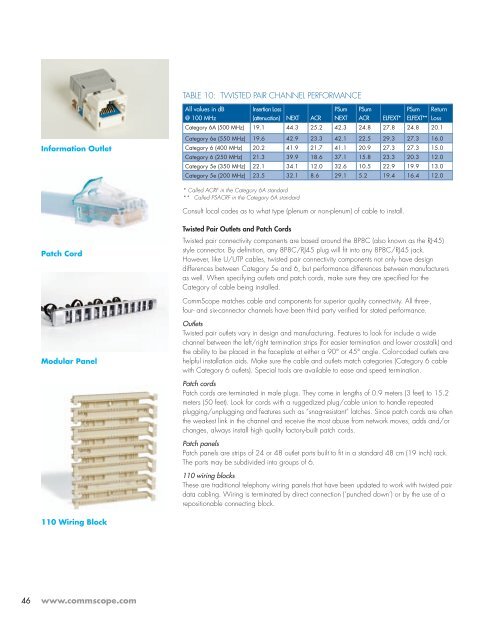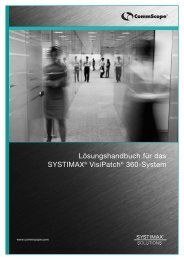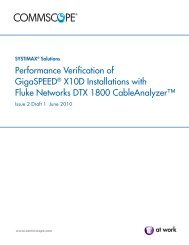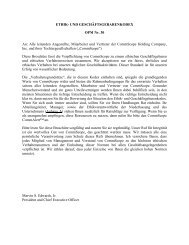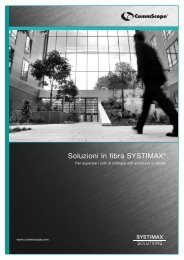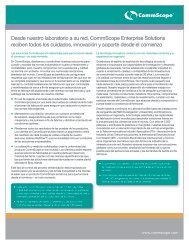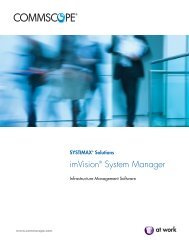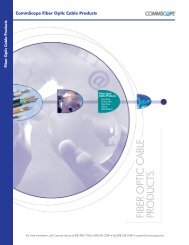CommScope® Enterprise Data Center Design Guide - Public ...
CommScope® Enterprise Data Center Design Guide - Public ...
CommScope® Enterprise Data Center Design Guide - Public ...
You also want an ePaper? Increase the reach of your titles
YUMPU automatically turns print PDFs into web optimized ePapers that Google loves.
46<br />
Information Outlet<br />
Patch Cord<br />
Modular Panel<br />
110 Wiring Block<br />
www.commscope.com<br />
TABLE 10: TWISTED PAIR CHANNEL PERFORMANCE<br />
All values in dB<br />
@ 100 MHz<br />
Insertion Loss<br />
(attenuation) NEXT ACR<br />
Consult local codes as to what type (plenum or non-plenum) of cable to install.<br />
Twisted Pair Outlets and Patch Cords<br />
Twisted pair connectivity components are based around the 8P8C (also known as the RJ-45)<br />
style connector. By definition, any 8P8C/RJ45 plug will fit into any 8P8C/RJ45 jack.<br />
However, like U/UTP cables, twisted pair connectivity components not only have design<br />
differences between Category 5e and 6, but performance differences between manufacturers<br />
as well. When specifying outlets and patch cords, make sure they are specified for the<br />
Category of cable being installed.<br />
CommScope matches cable and components for superior quality connectivity. All three-,<br />
four- and six-connector channels have been third party verified for stated performance.<br />
Outlets<br />
Twisted pair outlets vary in design and manufacturing. Features to look for include a wide<br />
channel between the left/right termination strips (for easier termination and lower crosstalk) and<br />
the ability to be placed in the faceplate at either a 90° or 45° angle. Color-coded outlets are<br />
helpful installation aids. Make sure the cable and outlets match categories (Category 6 cable<br />
with Category 6 outlets). Special tools are available to ease and speed termination.<br />
Patch cords<br />
Patch cords are terminated in male plugs. They come in lengths of 0.9 meters (3 feet) to 15.2<br />
meters (50 feet). Look for cords with a ruggedized plug/cable union to handle repeated<br />
plugging/unplugging and features such as “snag-resistant” latches. Since patch cords are often<br />
the weakest link in the channel and receive the most abuse from network moves, adds and/or<br />
changes, always install high quality factory-built patch cords.<br />
Patch panels<br />
Patch panels are strips of 24 or 48 outlet ports built to fit in a standard 48 cm (19 inch) rack.<br />
The ports may be subdivided into groups of 6.<br />
110 wiring blocks<br />
These are traditional telephony wiring panels that have been updated to work with twisted pair<br />
data cabling. Wiring is terminated by direct connection (‘punched down’) or by the use of a<br />
repositionable connecting block.<br />
PSum<br />
NEXT<br />
PSum<br />
ACR ELFEXT*<br />
PSum<br />
ELFEXT**<br />
Return<br />
Category 6A (500 MHz) 19.1 44.3 25.2 42.3 24.8 27.8 24.8 20.1<br />
Category 6e (550 MHz) 19.6 42.9 23.3 42.1 22.5 29.3 27.3 16.0<br />
Category 6 (400 MHz) 20.2 41.9 21.7 41.1 20.9 27.3 27.3 15.0<br />
Category 6 (250 MHz) 21.3 39.9 18.6 37.1 15.8 23.3 20.3 12.0<br />
Category 5e (350 MHz) 22.1 34.1 12.0 32.6 10.5 22.9 19.9 13.0<br />
Category 5e (200 MHz) 23.5 32.1 8.6 29.1 5.2 19.4 16.4 12.0<br />
* Called ACRF in the Category 6A standard<br />
** Called PSACRF in the Category 6A standard<br />
Loss


